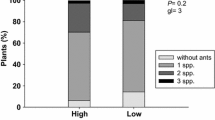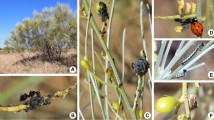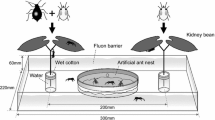Summary
We present two years of experimental and descriptive data which support the hypothesis that fireweed aphids (Aphis varians) compete with intra-and interspecific aphid neighbors for the services of ant mutualists (Formica fusca and F. cinerea). Specifically, we have shown that ants are a Limited and Limiting resource for a tended aphid species. First, the presence of heavily aphid-infested fireweed shoots significantly reduced the number of ants tending neighboring conspecific populations on fireweed. Second, the presence of ant-tended aphids (Cinara sp.) on Engelmann spruce significantly reduced the number of ants tending neighboring aphid populations on fireweed. Third, the number of ants, and not just the presence of ants, had a significant effect on the fitness of fireweed aphids. Aphid populations tended by three or more F. cinerea exhibited significantly higher probabilities of persisting and growing through time than colonies tended by one or two ants. Aphid populations tended by F. fusca had a significantly higher probability of growing when tended by three or more ants only if they had declined in size during the previous week.
Similar content being viewed by others
References
Addicott JF (1978a) Niche relationships among species of aphids feeding on fireweed. Can J Zool 56:1837–1841
Addicott JF (1978b) Competition for mutualists: aphids and ants. Can J Zool 56:2093–2096
Addicott JF (1978c) The population dynamics of aphids on fireweed: a comparison of local populations and metapopulations. Can J Zool 56:2554–2564
Addicott JF (1979) A multispecies aphid-ant association: density dependence and species-specific effects. Can J Zool 57:558–569
Addicott JF (1985) Competition in mutualistic systems. In: Boucher DH (ed) The biology of mutualism. Oxford University Press, NY
Beattie AJ (1985) The evolutionary ecology of ant-plant mutualisms. Cambridge University Press, London
Boucher DH, James S, Keeler KH (1982) The ecology of mutualism. Ann Rev Ecol Syst 13:315–347
Bristow CM (1984) Differential benefits from ant attendance to two species of Homoptera on New York Ironwood. J Anim Ecol 53:715–726
Blackman RL (1974) Aphids. Ginn and Company, London
Buckley R (1987) Ant-plant-homopteran interactions. Adv Ecol Res 16:53–85
Campbell DR (1985) Pollinator sharing and seed set of Stellaria pubera: competition for pollination. Ecology 66:544–553
Cushman JH, Whitham TG (1989) Conditional mutualism in a membracid-ant association: temporal, age-specific, and densitydependent effects. Ecology (in press)
Davidson DW, Morton SR (1981) Competition and dispersal in ant-dispersed plants. Science 213:1259–1261
Dixon WJ, Brown MB, Engelman L, Frane JW, Hill MA, Jennrich RI, (1985) BMDP statistical packages. University of California Press, Berkeley
Fritz RS (1982) An ant-treehopper mutualism: effects of Formica subsericea on the survival of Vanduzea arguata. Ecol Entomol 7:267–276
Heie OE (1980) The Aphidoidea (Hemiptera) of Fennoscandia and Denmark. I. Scandinavian Science Press Ltd., Klampenborg
Hughes RD (1963) Population dynamics of the cabbage aphid Brevicoryne brassice (L.). J Anim Ecol 32:393–424
Hurlbert SH (1984) Pseudoreplication and the design of ecological field experiments. Ecol Monogr 54:187–211
Kephardt SR (1983) The partitioning of pollinators among three species of Asclepias. Ecology 64:120–133
Langenheim JH (1962) Vegetation and environmental patterns in the Crested Butte area, Gunnison County, Colorado. Ecol Monogr 32:349–385
McEvoy PB (1979) Advantages and disadvantages to group living in treehoppers (Homoptera: Membracidae). Misc Pub Ent Soc Am 11:1–13
Messina FJ (1981) Plant protection as a consequence of an antmembracid mutualism: interactions on goldenrod (Solidago sp.). Ecology 62:1433–1440
Nixon GEJ (1951) The association of ant with aphids and coccids. Commonwealth Institute of Entomology, London
Rathcke B (1983) Competition and facilitation among plants for pollinators. In: Real LA (ed) Pollination biology. Academic Press, NY
Waser NM (1978) Competition for hummingbird pollination and sequential flowering in two Colorado wildflowers. Ecology 59:934–944
Waser NM (1983) Competition for pollinators and floral character differences among sympatric plant species: a review of evidence. In: Jones CE, Little RJ (eds) Handbook of experimental pollination biology. Van Nostrand Reinhold, NY
Way MJ (1971) Mutualism between ants and honeydew-producing Homoptera. Ann Rev Entomol 8:307–344
Winer BJ (1971) Statistical principles in experimental design. McGraw-Hill, NY
Wood TK (1982) Ant-attended nymphal aggregations in the Enchenopa binotata complex (Homoptera: Membracidae). Ann Ent Soc Am 75:649–653
Author information
Authors and Affiliations
Rights and permissions
About this article
Cite this article
Cushman, J.H., Addicott, J.F. Intra- and interspecific competition for mutualists: ants as a limited and limiting resource for aphids. Oecologia 79, 315–321 (1989). https://doi.org/10.1007/BF00384310
Received:
Published:
Issue Date:
DOI: https://doi.org/10.1007/BF00384310




